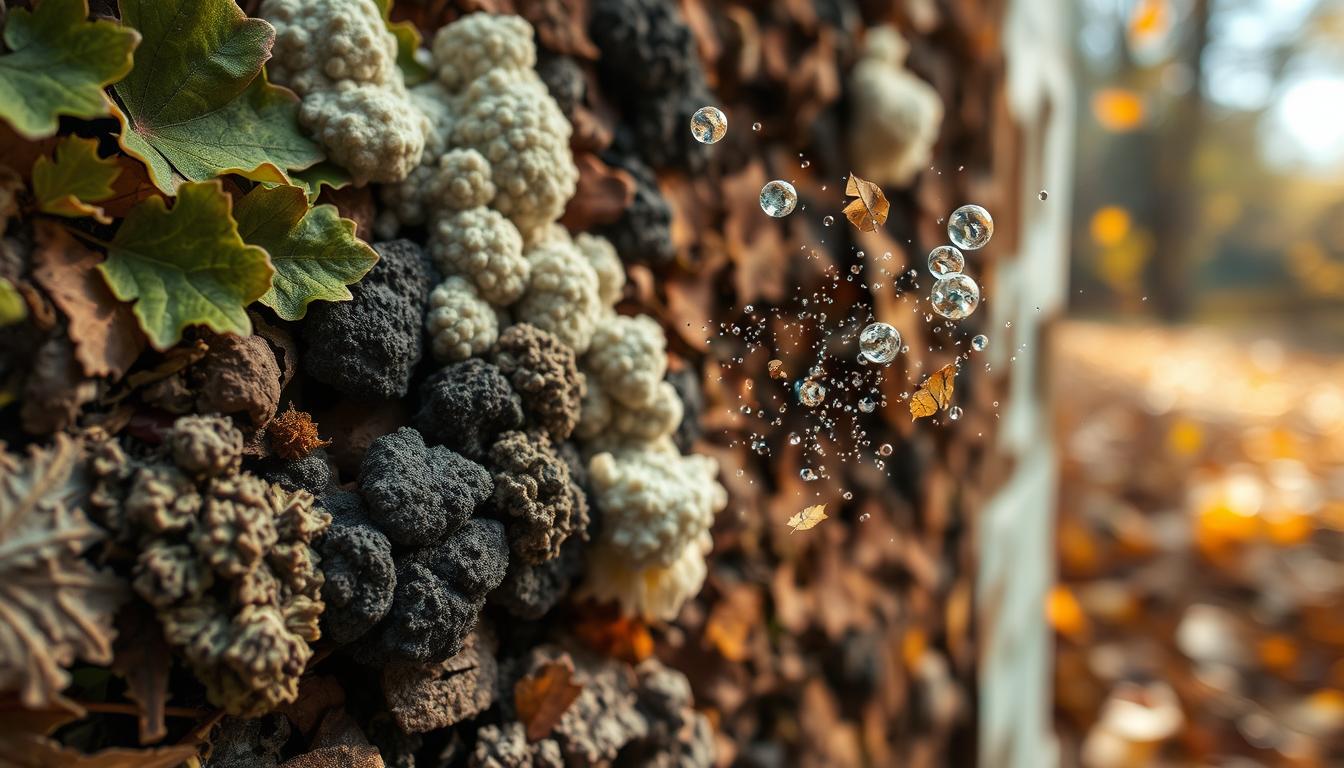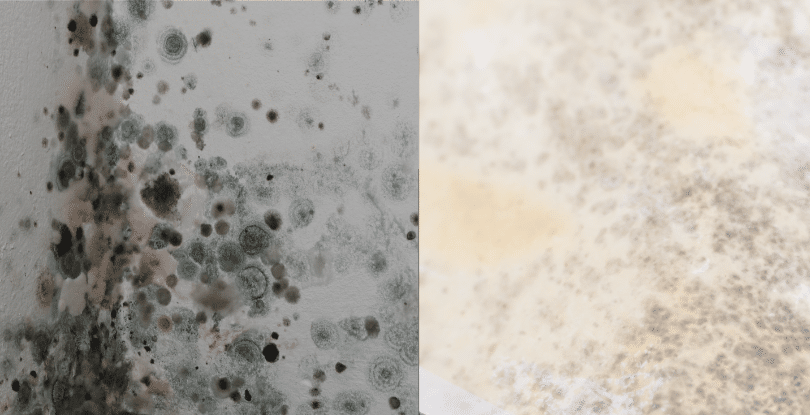Seasonal Mold Allergy Symptoms
Did you know that over 1,000 species of mold exist in the United States, and a staggering 3-10% of people have a mold allergy? Mold spores are virtually invisible to the naked eye, yet they can trigger a range of allergy symptoms that may leave you feeling miserable, especially during humid seasons. As someone who has experienced the discomfort of mold allergies myself, I’m well aware of the importance of understanding the seasonal patterns and warning signs associated with this common environmental allergen.
Key Takeaways
- Mold allergies can cause sneezing, runny nose, stuffy nose, itchy eyes, coughing, and wheezing.
- Symptoms can occur year-round, but often peak during humid seasons like summer and fall.
- Common allergenic molds include Alternaria, Aspergillus, Cladosporium, and Penicillium.
- Mold exposure can trigger immediate or delayed allergic reactions and worsen asthma symptoms.
- Reducing indoor humidity, using air filters, and avoiding damp areas can help prevent mold allergies.
Understanding Mold Allergies: Basic Facts and Triggers
Mold is a common allergen that can trigger a range of respiratory symptoms. As a fungus that thrives in damp environments, mold produces airborne spores that can cause allergic reactions when inhaled. Understanding the common types of allergenic molds, how they affect your health, and the indoor and outdoor sources of mold exposure is crucial for managing mold allergies effectively.
Common Types of Allergenic Molds
Some of the most common molds that can trigger allergy symptoms include Alternaria, Aspergillus, Cladosporium, and Penicillium. These mold species are known to be highly allergenic and can cause a variety of respiratory issues, from nasal congestion to asthma flare-ups.
How Mold Spores Affect Your Health
Mold spores can reach the respiratory system when inhaled, leading to allergic reactions that affect the eyes, nose, sinuses, and lungs. Symptoms can range from mild, like sneezing and itchy eyes, to more severe, such as wheezing and difficulty breathing. Mold exposure can also trigger or worsen asthma, and in rare cases, lead to conditions like allergic bronchopulmonary aspergillosis.
Indoor vs Outdoor Mold Sources
Mold can grow both indoors and outdoors, presenting year-round exposure risks. Outdoor mold sources include rotting logs, fallen leaves, and compost piles, with peak activity often occurring from spring to fall. Indoor mold can thrive in damp areas like bathrooms, kitchens, and basements, causing allergy symptoms that may persist throughout the year.
| Mold Allergy Triggers | Indoor Mold Sources | Outdoor Mold Sources |
|---|---|---|
| Alternaria, Aspergillus, Cladosporium, Penicillium | Bathrooms, kitchens, basements | Rotting logs, fallen leaves, compost piles |
By understanding the common mold types, how they affect your health, and the various indoor and outdoor sources of mold, you can better prepare for and manage your mold allergies throughout the year.
Seasonal Mold Allergy Symptoms: Key Warning Signs
If you suffer from seasonal mold allergies, it’s crucial to be aware of the key warning signs that may arise. Mold allergy symptoms can range from mild to severe, often fluctuating with changes in weather conditions or exposure to high-mold environments.
One of the most common mold allergy symptoms is a runny or stuffy nose. You may also experience frequent sneezing, as well as itchy, watery eyes, nose, and throat. Some individuals even develop a dry, scaly skin rash as a result of their mold allergy.
In susceptible individuals, mold allergies can also trigger asthma-like symptoms, including wheezing, shortness of breath, and chest tightness. These respiratory issues can be particularly problematic, as exposure to mold spores can lead to conditions like allergic bronchopulmonary aspergillosis.
Monitoring your symptoms and identifying potential mold triggers is essential for managing your seasonal allergies. By understanding the allergy signs associated with mold, you can take proactive steps to reduce your exposure and find relief.
| Mold Allergy Symptom | Description |
|---|---|
| Runny or Stuffy Nose | Nasal congestion and increased mucus production are common reactions to mold exposure. |
| Sneezing | Mold spores can trigger the immune system, leading to repeated sneezing fits. |
| Itchy, Watery Eyes | Mold allergens can cause inflammation and irritation in the eyes, leading to itchiness and excessive tearing. |
| Coughing and Postnasal Drip | Mold exposure can cause throat irritation, leading to coughing and a sensation of mucus dripping down the back of the throat. |
| Skin Rash | Some individuals may develop a dry, scaly rash on their skin as a reaction to mold allergens. |
| Asthma Symptoms | Mold can trigger asthma attacks, leading to wheezing, shortness of breath, and chest tightness. |

By recognizing these common mold allergy symptoms, you can take proactive steps to manage your condition and reduce the impact on your daily life.
When Mold Allergies Peak: Understanding the Seasonal Patterns
Mold allergies can be a year-round concern, but they tend to peak during specific seasons. Understanding the seasonal patterns of mold growth and spore release is key to managing your symptoms effectively.
Spring and Early Summer Mold Growth
As the weather warms up and plants begin to decompose, outdoor mold activity surges in the spring and early summer months. This is a prime time for many people with seasonal mold allergies to experience heightened symptoms, such as sneezing, nasal congestion, and itchy, watery eyes.
Fall Mold Activity Patterns
The fall season brings another wave of mold-related allergy troubles. As leaves and other vegetation begin to decay, mold spore counts can skyrocket, triggering allergy flare-ups in susceptible individuals. Periods of warm, humid weather in the fall tend to be especially problematic for those with seasonal mold allergies.
Year-round Indoor Exposure Risks
While outdoor mold growth follows seasonal patterns, indoor mold can be a year-round concern. Damp areas of the home, such as bathrooms, basements, and kitchens, provide the perfect environment for mold to thrive. Consistent exposure to indoor mold can lead to persistent allergy symptoms, even during the “off-season” for outdoor mold.
Monitoring mold spore counts and taking precautions during peak seasons can help individuals with seasonal mold allergies better manage their symptoms and find relief. By understanding the seasonal patterns of mold growth, you can take proactive steps to minimize exposure and maintain your health throughout the year.
How Mold Allergies Affect Your Respiratory System
Mold allergies can have a significant impact on your respiratory health. When exposed to mold spores, your immune system may overreact, triggering an allergic reaction in your airways. This can lead to a variety of uncomfortable respiratory symptoms, making it crucial to understand how mold allergies affect your breathing.
One of the primary ways mold allergies impact the respiratory system is by causing inflammation in the airways. The presence of mold spores can irritate the delicate tissues lining your nose, throat, and lungs, leading to conditions like coughing, wheezing, and nasal congestion. In severe cases, mold exposure can even trigger asthma attacks in individuals with pre-existing asthma.
Prolonged exposure to mold can also make you more sensitive to other common allergens, exacerbating your respiratory symptoms. Over time, this can lead to chronic respiratory issues and a worsening of your overall allergy-related health concerns.
| Respiratory Symptoms of Mold Allergies | Potential Impact |
|---|---|
| Coughing | Irritation and inflammation in the airways |
| Wheezing | Narrowing and obstruction of the airways |
| Nasal Congestion | Swelling and blocked nasal passages |
| Asthma Exacerbation | Increased risk of severe asthma attacks |
To effectively manage mold-related respiratory symptoms, it’s important to work closely with your healthcare provider. They can help you identify the specific mold allergens triggering your reactions and develop a comprehensive treatment plan to alleviate your discomfort and prevent long-term respiratory complications.

The Connection Between Mold Allergies and Asthma
Mold allergies can significantly impact asthma, potentially triggering or worsening asthma symptoms. Mold-induced asthma is characterized by coughing, wheezing, shortness of breath, and chest tightness when exposed to mold spores. In fact, nearly a thousand different species of mold are found in the United States alone, and mold prefers warm, humid environments like kitchens and bathrooms.
Triggers for Mold-Induced Asthma
Asthma attacks can be triggered by allergens like mold, pollen, or pet dander. Mold spores can cause symptoms like runny nose, nasal congestion, sneezing, and itchy/watery eyes for those with mold allergies. Symptoms of an asthma attack triggered by mold exposure can include coughing, wheezing, shortness of breath, and chest tightness.
Managing Asthma During Peak Mold Seasons
To manage asthma during peak mold seasons, it’s important to use prescribed medications, avoid high-mold areas, and maintain good indoor air quality. Strategies to prevent mold exposure include using a dehumidifier, central air-conditioning with a HEPA filter, air purifiers, exhaust fans, and prompt plumbing leak repairs. By taking these proactive steps, individuals with mold allergies and asthma can better manage their condition and reduce the risk of severe asthma attacks.
“Mold allergies can significantly impact asthma, potentially triggering or worsening asthma symptoms.”
Diagnosing Mold Allergies: Tests and Procedures
Determining if you have a mold allergy is a crucial first step in addressing respiratory issues and taking appropriate action. The diagnostic process typically involves a combination of medical history review, physical examination, and specialized allergy tests. One of the most common tests for mold allergies is the skin prick test, where small amounts of mold extracts are placed on the skin to see if any allergic reactions occur.
In addition to the skin prick test, your allergist may also recommend a blood test to measure the levels of mold-specific antibodies in your system. This can provide valuable insights into the specific types of molds triggering your allergic responses. Keeping a detailed symptom diary can also help correlate your symptoms with potential mold exposures, providing important clues for the diagnosis.
For individuals with asthma or other respiratory conditions, pulmonary function tests may be performed to assess the impact of mold exposure on lung function. These tests can help determine the severity of the allergy and guide appropriate treatment options.
| Diagnostic Method | Description |
|---|---|
| Skin Prick Test | Tiny amounts of mold extracts are placed on the skin to observe any allergic reactions. |
| Blood Test | Measures the levels of mold-specific antibodies to identify the culprit molds. |
| Symptom Diary | Records when and where symptoms occur to help pinpoint mold exposure triggers. |
| Pulmonary Function Test | Assesses the impact of mold exposure on lung function, especially in individuals with asthma. |
By combining these diagnostic tests and procedures, your healthcare provider can accurately identify the specific molds causing your allergic reactions and develop an effective treatment plan to manage your symptoms and improve your overall respiratory health.
Effective Treatment Options for Mold Allergies
Dealing with mold allergies can be a real challenge, but the good news is that there are several effective treatment options available. From over-the-counter medications to more advanced immunotherapy, we have a range of solutions to help alleviate your symptoms and manage this common allergy.
Medication Options
For milder mold allergy symptoms, over-the-counter antihistamines like loratadine (Claritin) and cetirizine (Zyrtec) can provide relief by blocking the release of histamine, which causes those pesky sneezes and itchy eyes. Decongestants can also help clear nasal congestion, but be cautious of prolonged use as they may lead to rebound congestion.
For more severe cases, prescription nasal corticosteroids like fluticasone (Flonase), ciclesonide (Omnaris), and mometasone (Nasonex) are often the first line of defense. These medications work by reducing inflammation in the nasal passages and can be highly effective in managing mold allergy symptoms.
Immunotherapy Considerations
If medications alone don’t provide sufficient relief, immunotherapy may be a viable option. Also known as allergy shots or tablets, immunotherapy involves gradually exposing your body to the mold allergens, allowing your immune system to build up tolerance over time. This can lead to long-term relief and even a potential reduction in mold allergy symptoms.
Natural Remedies and Solutions
In addition to medication, there are several natural remedies that can help manage mold allergies. Nasal lavage, or rinsing the nasal passages with a saline solution, can provide soothing relief and help flush out irritants. Maintaining a clean, low-humidity environment at home by using air purifiers and dehumidifiers can also go a long way in reducing mold exposure and minimizing allergy symptoms.
Remember, the key to effectively treating mold allergies is to work closely with your healthcare provider to develop a customized plan that addresses your specific needs and concerns. With the right approach, you can take control of your mold allergies and enjoy a healthier, more comfortable life.
Prevention Strategies: Reducing Mold Exposure at Home
Preventing mold growth at home is crucial for maintaining good indoor air quality and safeguarding your health. By implementing effective mold prevention strategies, you can take proactive steps to control indoor mold and minimize your exposure to this common household allergen.
One of the key measures is to control humidity levels in your home. Aim to keep the indoor relative humidity below 60%, ideally between 35% and 50%. Using dehumidifiers in damp areas, such as basements or bathrooms, can help maintain optimal moisture levels and inhibit mold growth.
- Ensure proper ventilation in kitchens, bathrooms, and other moisture-prone areas to prevent the buildup of excess humidity.
- Fix any water leaks or sources of moisture intrusion promptly to address the root cause of potential mold problems.
- Regularly clean and dry surfaces prone to mold, such as shower curtains, windowsills, and grout lines.
When it comes to home improvement projects, consider using mold-resistant building materials and products. This can include paints, caulks, and sealants that are formulated to inhibit mold growth. Additionally, the use of HEPA air filters in your home’s HVAC system can significantly reduce the presence of airborne mold spores.
“Controlling indoor mold and maintaining healthy home air quality are essential for creating a safe and comfortable living environment.”
By implementing these mold prevention strategies, you can effectively reduce your exposure to this common household allergen and safeguard the wellbeing of your family. Remember, proactive measures are key to maintaining a mold-free, healthy home.
Monitoring and Controlling Indoor Humidity Levels
Maintaining optimal indoor humidity levels is crucial for preventing mold growth and allergens that can trigger unpleasant symptoms. The ideal indoor humidity range is typically below 50%, as higher levels can create an environment conducive to mold and mildew development. By closely monitoring humidity levels using a hygrometer and employing dehumidifiers in areas prone to excess moisture, you can effectively manage the indoor environment and reduce the risk of mold-related health issues.
Proper ventilation is key to regulating humidity, especially in high-moisture zones like bathrooms and kitchens. Ensuring adequate airflow and addressing any sources of excess moisture, such as leaks or condensation, can help mitigate mold growth. Additionally, regular cleaning and maintenance of air conditioning systems and dehumidifiers themselves can prevent these appliances from becoming breeding grounds for mold spores.
- Use a hygrometer to monitor indoor humidity levels and aim to keep them below 50%.
- Employ dehumidifiers in areas prone to excess moisture, such as basements and bathrooms.
- Maintain proper ventilation, especially in high-moisture areas, to regulate humidity.
- Address any sources of excess moisture, such as leaks or condensation, to prevent mold growth.
- Regularly clean and maintain air conditioning systems and dehumidifiers to prevent mold buildup.
By taking proactive steps to monitor and control indoor humidity levels, you can create a healthier living environment and effectively reduce the risk of mold-related allergies and respiratory issues. Remember, prevention is key when it comes to maintaining a mold-free home and protecting your family’s well-being.
Conclusion
Effectively managing mold allergies requires a multi-faceted approach that combines avoidance, symptom relief, and long-term treatment. By understanding the seasonal patterns and identifying personal triggers, I can take proactive steps to minimize mold exposure and alleviate uncomfortable allergy symptoms. Regular consultations with an allergist, adherence to prescribed treatment plans, and creating a mold-resistant environment at home are all crucial elements of mold allergy management.
Immunotherapy, whether through subcutaneous injections or sublingual tablets, can be an effective long-term solution for individuals with severe mold allergies or a family history of allergies. While the benefits of this approach may take 3 to 5 years to fully manifest, the improvement in quality of life can be life-changing. Alongside medical interventions, utilizing air purifiers, maintaining optimal indoor humidity levels, and following other prevention strategies can significantly reduce mold allergy symptoms and the risk of complications like asthma.
By staying vigilant, working closely with healthcare professionals, and implementing a comprehensive mold allergy management plan, I can take control of my condition and enjoy a better quality of life, free from the debilitating effects of mold exposure. With the right knowledge and proactive steps, mold allergies can be effectively managed, allowing me to fully embrace the changing seasons without the burden of seasonal symptoms.
FAQ
What are the common symptoms of mold allergies?
Mold allergies can cause symptoms similar to other respiratory allergies, including sneezing, runny nose, stuffy nose, itchy eyes, coughing, and wheezing. These symptoms can occur year-round but often peak during humid seasons.
What are the most common types of allergenic molds?
Some of the most common allergenic molds include Alternaria, Aspergillus, Cladosporium, and Penicillium. These molds produce airborne spores that can trigger allergic reactions when inhaled.
How do mold spores affect my health?
Exposure to mold spores can trigger immediate or delayed allergic reactions, affecting the respiratory system. In some cases, mold exposure can also worsen asthma symptoms.
Where can I find mold growing indoors and outdoors?
Indoor mold sources include bathrooms, kitchens, and basements, while outdoor sources include rotting logs, fallen leaves, and compost piles. Mold thrives in damp environments.
When do mold allergy symptoms typically peak?
Mold allergy symptoms often peak from spring to fall, with high humidity promoting mold growth. Spring and early summer see increased outdoor mold activity, while fall brings another surge as molds thrive on fallen leaves and dying vegetation.
How can mold allergies affect asthma?
Mold allergies can significantly impact asthma, potentially triggering or worsening asthma symptoms. Mold-induced asthma is characterized by coughing, wheezing, shortness of breath, and chest tightness when exposed to mold spores.
How are mold allergies diagnosed?
Diagnosing mold allergies typically involves a combination of medical history, physical examination, and allergy tests, such as skin prick tests and blood tests to detect mold-specific antibodies.
What are the treatment options for mold allergies?
Treatment for mold allergies includes over-the-counter and prescription medications, such as antihistamines, decongestants, and nasal corticosteroids. For severe cases, immunotherapy (allergy shots or tablets) may be recommended to build tolerance to mold allergens.
How can I prevent mold growth at home?
Preventing mold growth at home involves controlling moisture levels, improving ventilation, and promptly addressing water damage. Use dehumidifiers, fix leaks, and regularly clean and dry areas prone to mold growth.
Why is controlling indoor humidity levels important for mold prevention?
Maintaining indoor humidity levels below 50% is crucial for preventing mold growth. Use hygrometers to monitor humidity levels and employ dehumidifiers in high-moisture areas. Ensure proper ventilation and address any sources of excess moisture.




